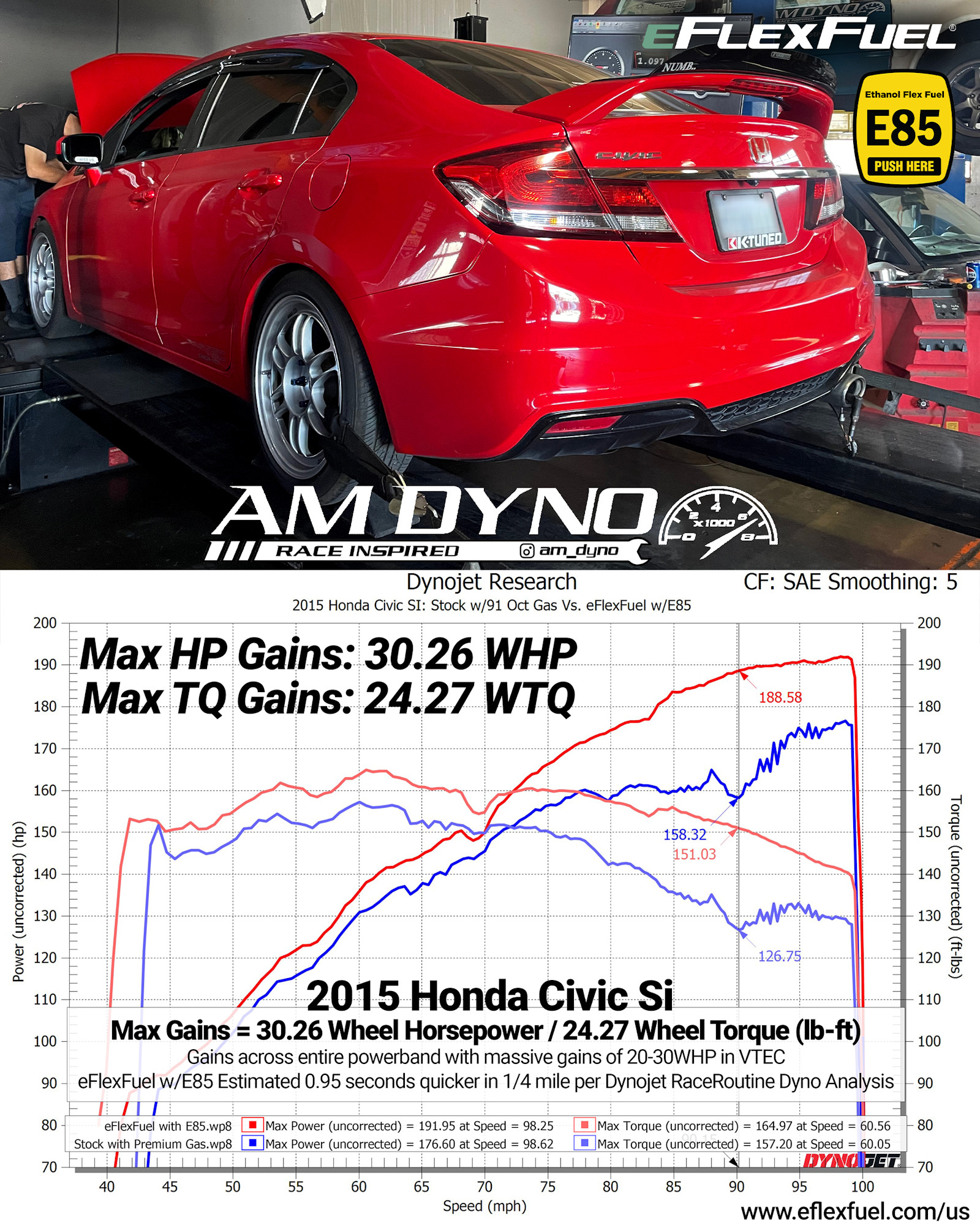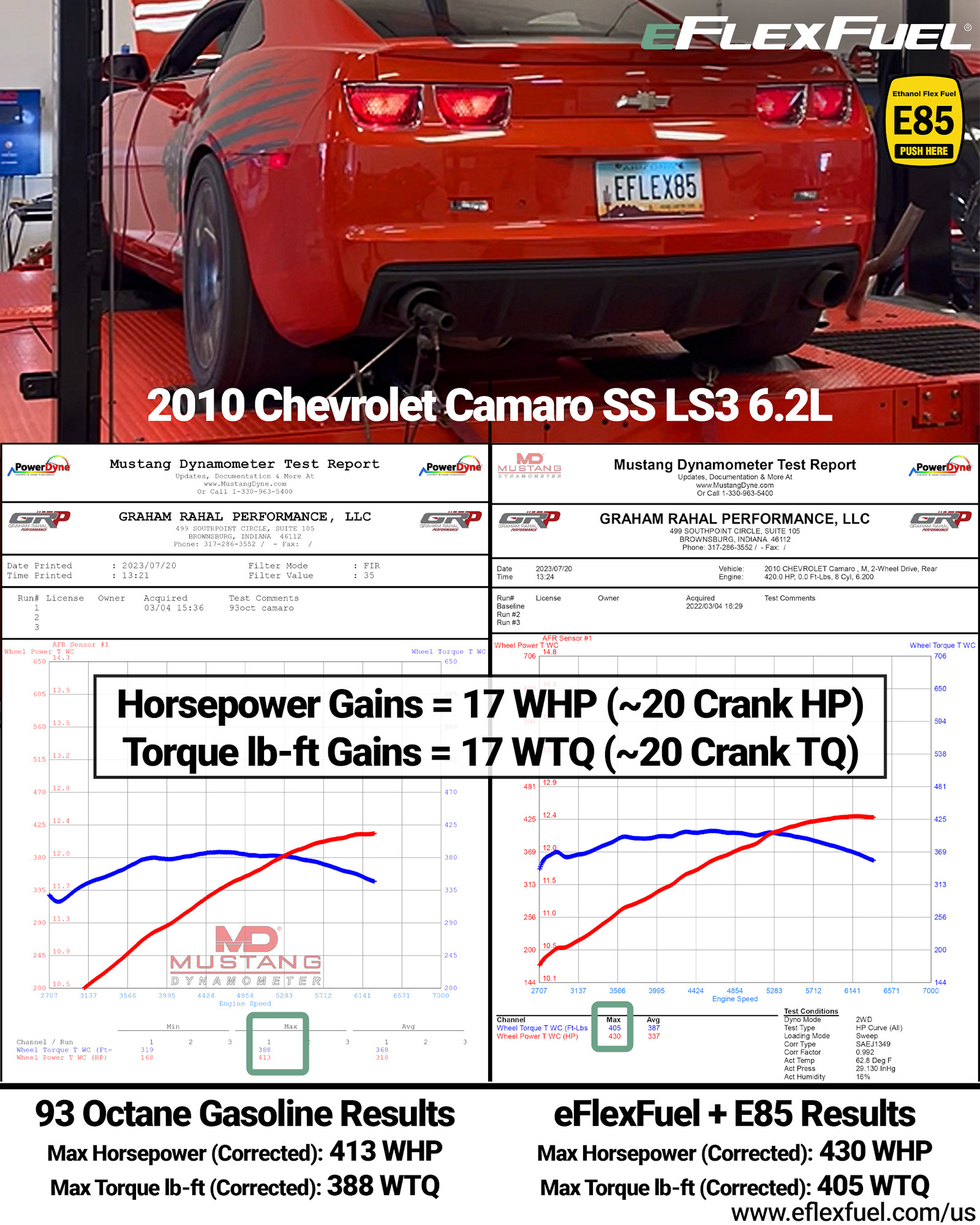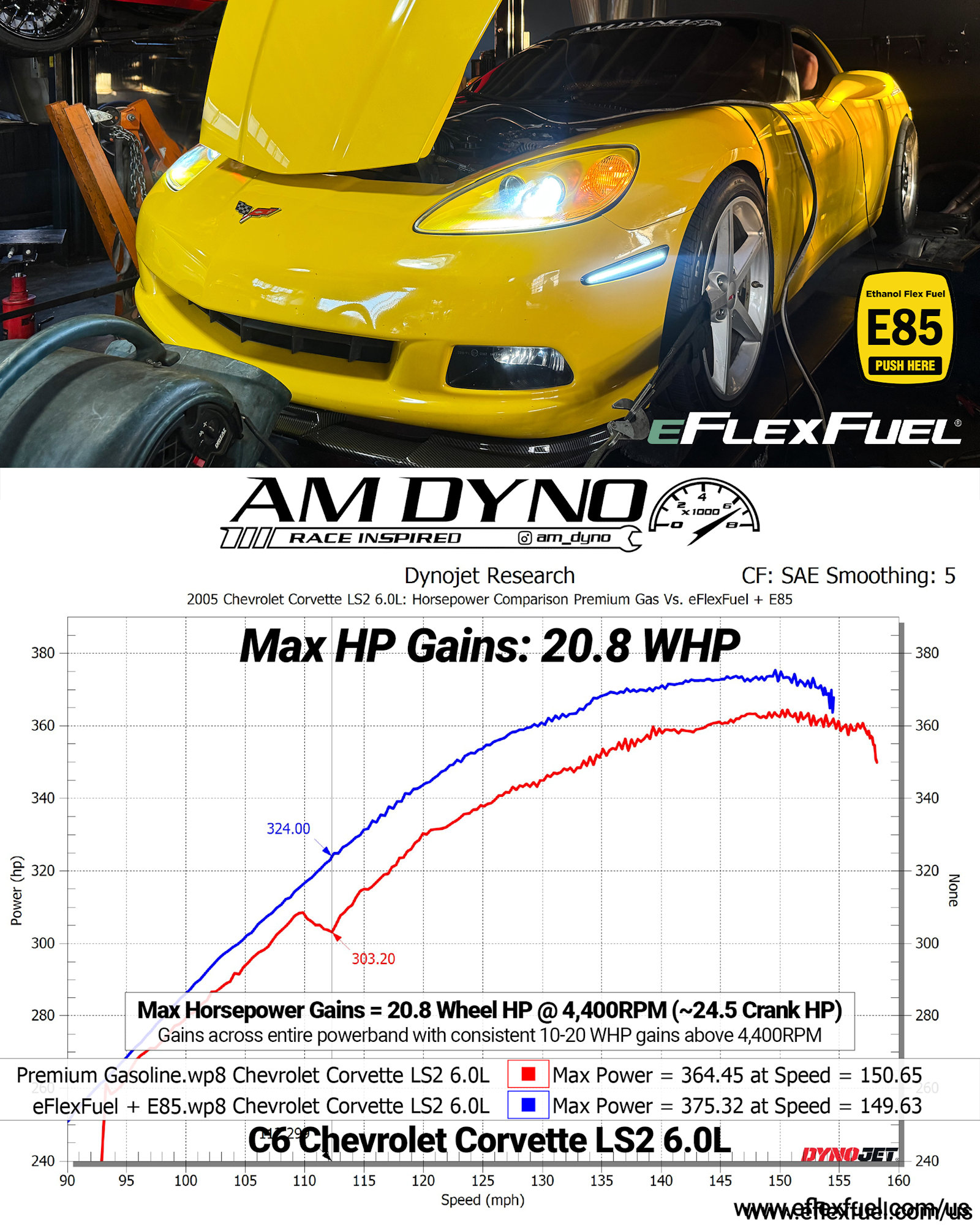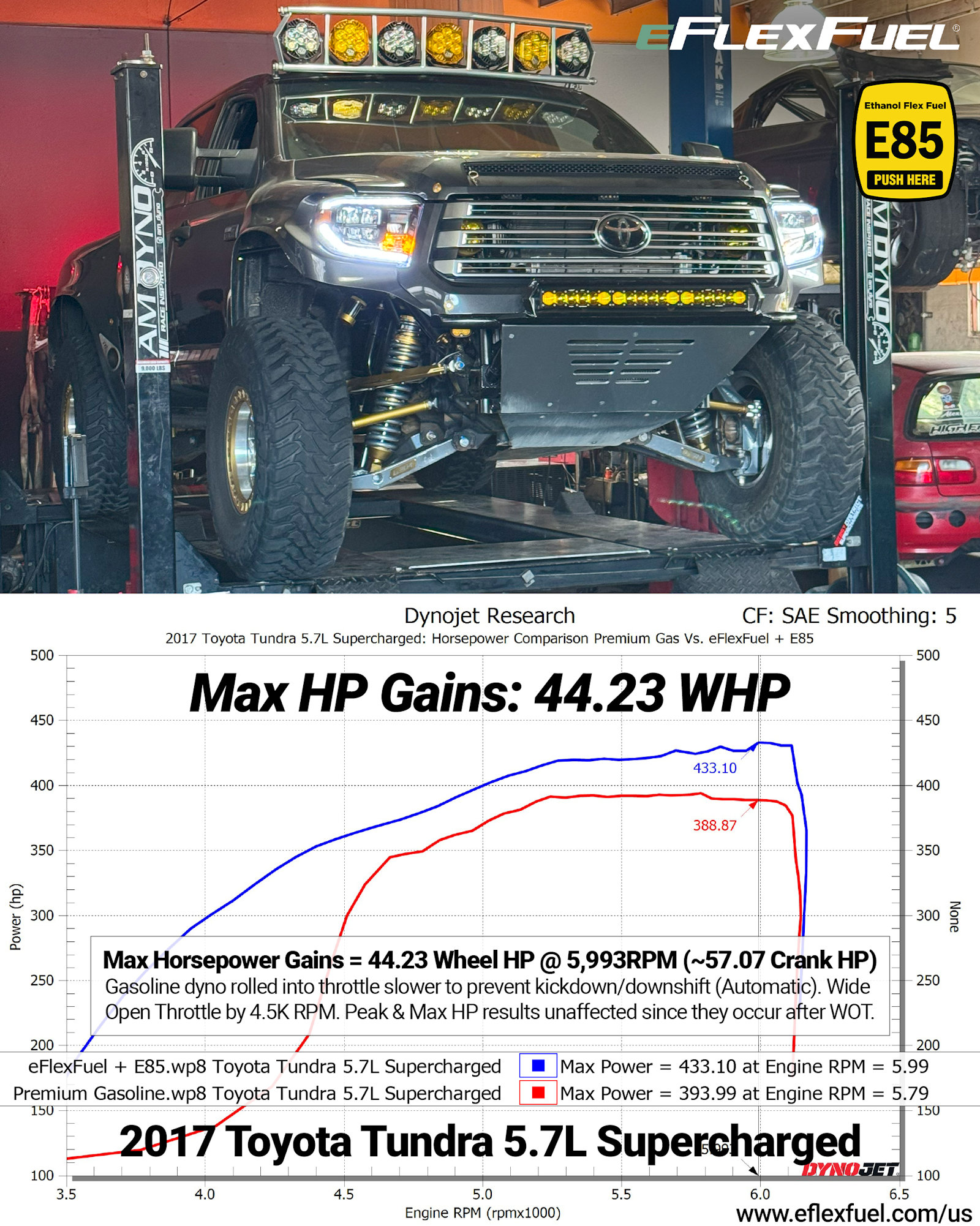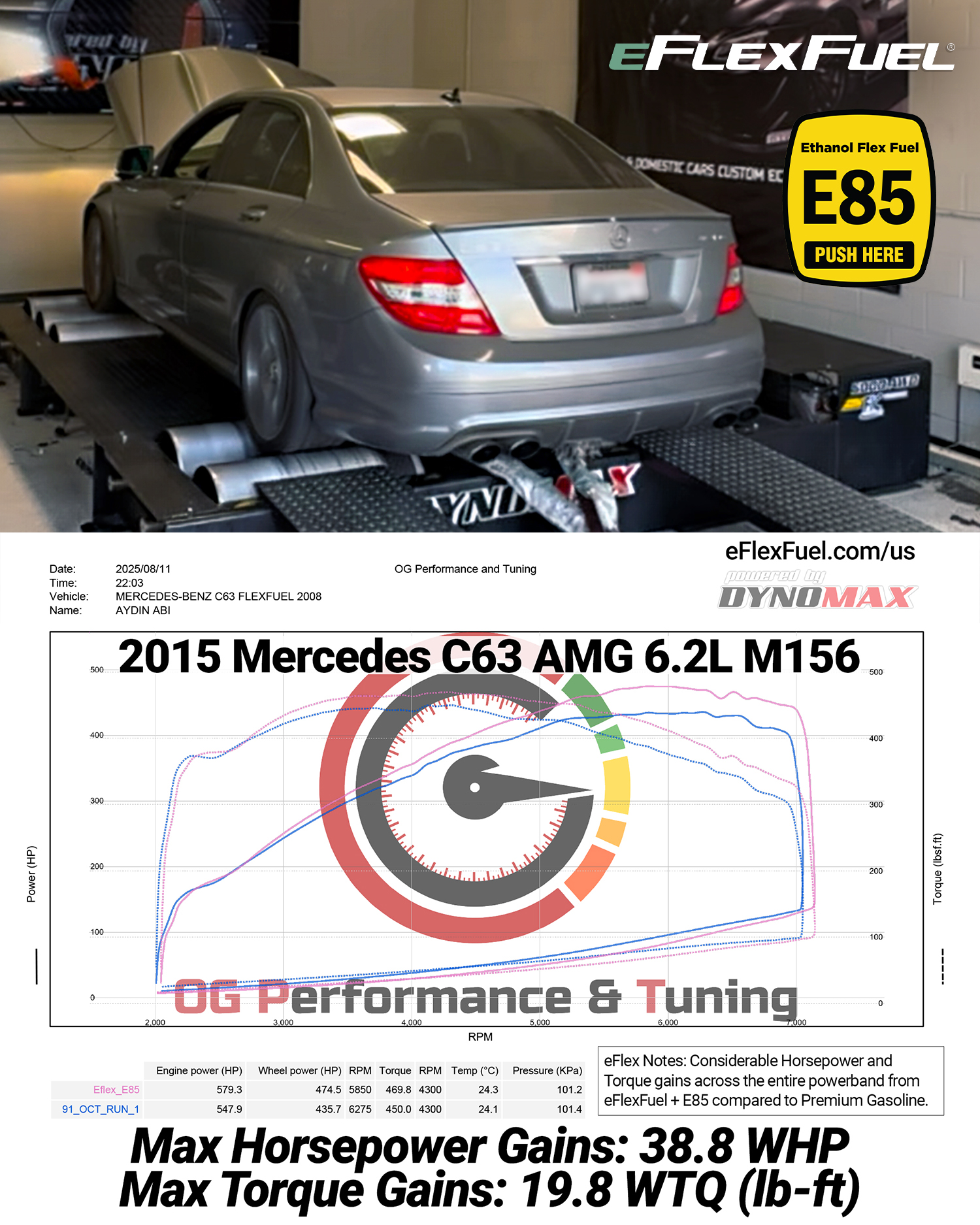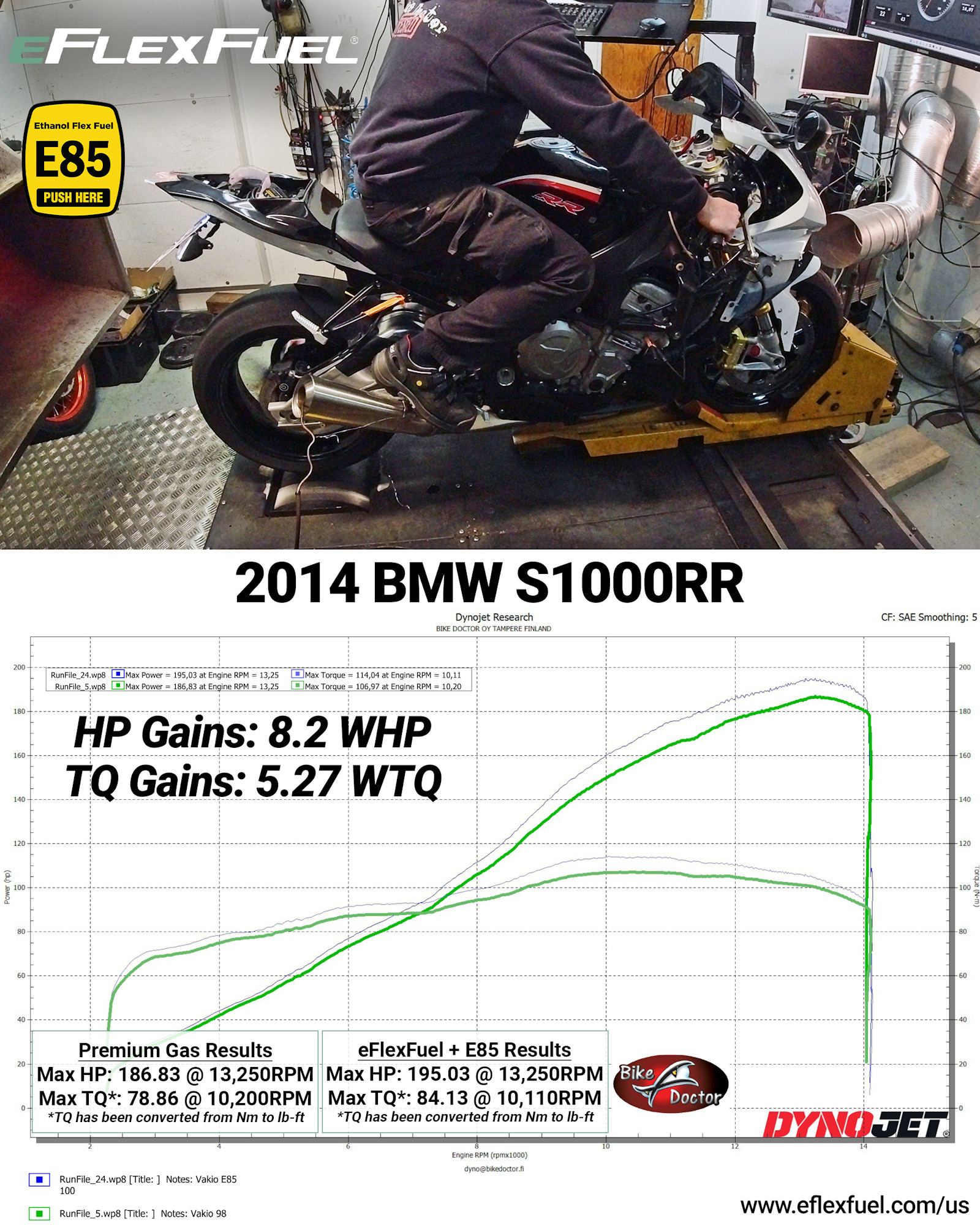eFlexFuel: The E85 Gamechanger
Think you know what it takes to run E85 in your car, truck, or motorcycle and make more power? Think again.
Forget What You Thought You Knew About E85
- Forget about tuning.
- Forget about changing fuel maps.
- Forget about upgrading your entire fuel system.
- Forget about aftermarket injectors (in most applications).
- Forget about making changes to your engine or ECM.
- Forget about measuring ethanol percent at the pumps.
- Forget about having to run the same Ethanol percentage all the time.
- Forget about complex systems that need a certified technician for installation.
eFlexFuel is the next generation of E85 flex fuel conversions. All eFlexFuel kits install under the hood and allow you to run E85, gasoline, or any mix of the two automatically and without touching the vehicle’s ECM.
Our kits challenge old-school ideas around “E85 tuning” but we have the data and experience to back up our claims – we even include a 5-year warranty. We invite you to explore this page to understand why more than 65,000 customers have enabled their vehicles to run E85 and gasoline with eFlexFuel.
But First, What Is E85 Fuel?
E85 fuel is a clean-burning, high-octane blend of up to 85% ethanol and gasoline that reduces emissions, supports renewable energy, boosts engine performance, and decreases dependence on foreign oil compared to traditional gasoline and fossil fuels.
The name “E85” has nothing to do with octane. The “E” in E85 stands for Ethanol while the “85” represents the percentage of Ethanol. “E85” is “Ethanol 85%” fuel, or fuel with 85% Ethanol content. E10 is 10% Ethanol, E15 is 15% Ethanol, and so on.
Many people don’t realize that E85 and the gasoline they pump at the gas station (A.K.A. “pump gas”) are made up of the same ingredients, just in different ratios: pump gas is an alcohol-gasoline blend of 10% ethanol with 90% gasoline and other hydrocarbons. That’s right – your vehicle already runs ethanol blended fuel, E10! E85 is also an alcohol-gasoline blend, but with a ratio of up to 85% Ethanol with 15% gasoline and other hydrocarbons.
In simplified terms, the main difference between “pump gasoline” (E10) and E85 is the ratio of Ethanol to gasoline and other hydrocarbons. In other words, E85 just has more Ethanol - that’s it!
My Car/Truck/Bike Already Runs Great On “Pump Gas,” Why Should I Care About E85?
If you’re only using pump gas, you’re leaving performance and dollars on the table, guaranteed. If your car/truck/bike already runs great on pump gas, it will run even better on E85 via eFlexFuel thanks to E85’s chemical composition and combustion principles. Looking for any of the following?
- Increased Horsepower & Torque
- Improved Responsiveness
- Smoother Engine Operation
- Cleaner Fuel System & Combustion
- Lower Cost Fuel
- Reduced Harmful Emissions
If your answer was “yes” to any of these benefits, then E85 via eFlexFuel is worth exploring.
E85 is low cost, environmentally friendly race fuel available at thousands of gas stations across the country that you can run once you install an eFlexFuel kit in your vehicle.
How Do eFlexFuel Kits Work Without Tuning, Touching The Vehicle’s Ecm, Or Changing Other Components?
eFlexFuel technology leverages the science of stoichiometry with cutting edge electronics to deliver seamless fueling regardless of the ethanol percentage in your fuel.
eFlexFuel systems work in conjunction with your vehicle’s ECU to deliver precise fueling for gasoline, E85, and any mixture of these two fuels. To accomplish this, eFlexFuel analyzes the fuel’s ethanol content over 100 times per second while processing each injector’s native fueling signal. This data is combined to yield optimized injector output for the current ethanol-gasoline blend. As the fuel blend changes, eFlexFuel instantaneously adapts with it. eFlexFuel’s fuel delivery adjustments are real-time, seamless, and fully automatically, providing ultimate drivability regardless of fuel.
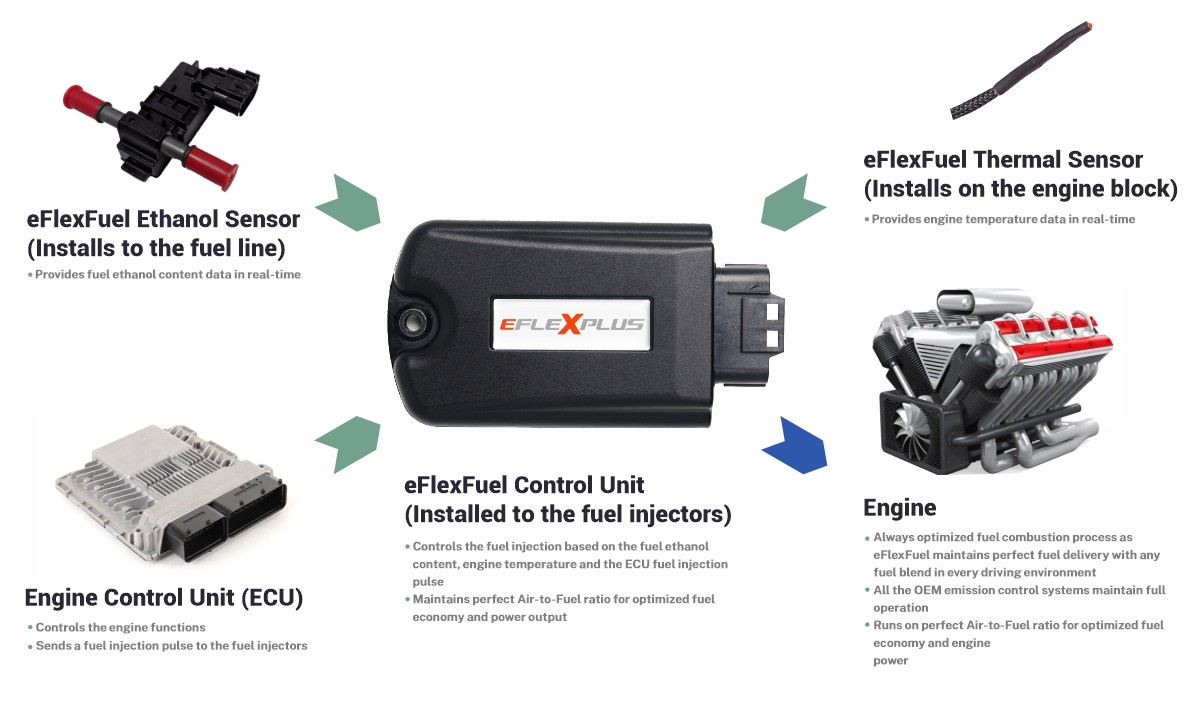
- Real-Time Ethanol Sensing and Automatic Adjustment: eFlexFuel kits include an ethanol content sensor that is installed in-line with the fuel system. This sensor continuously measures the ethanol percentage in the fuel allowing the eFlexFuel Control Unit to automatically adjust the fuel injection volume, ensuring the engine always receives the correct air-fuel mixture for optimal performance and emissions, regardless of the ethanol content.
- No ECM Modification Required: Unlike traditional tuning or chip modifications, eFlexFuel systems operate independently of the vehicle’s factory ECM. eFlexFuel kits do not reprogram or interfere with the original engine management system. All OEM safety features and adaptive functions remain intact, and the kit does not trigger check engine lights or diagnostic trouble codes.
- Plug-and-Play Installation: eFlexFuel kits are designed for straightforward installation, typically requiring only basic tools to connect to the fuel injectors and fuel lines without the need to replace or modify the ECM, fuel pump, or other major components. This makes it possible to revert to the original setup if desired.

True Fueling Flexibility: Can You Really Mix E85 And Pump Gas Together With eFlexFuel?
eFlexFuel kits allow you to run E85, gas, or any mixture of these two fuels automatically. Unchain yourself from pump gas and fill up with whatever is cheaper and more convenient – but we promise you’ll want to fill up with E85 when you can!
How this works: Because both E85 and gasoline are essentially made up of the same two ingredients, mixing pump gas (10% ethanol + 90% gasoline) with E85 (85% ethanol + 15% gasoline) simply changes the final ratio between ethanol and gasoline. This is why you can have a half tank of E85 and fill up the remainder with gasoline (E10) and the two naturally combine without issue: you are just forming a new ethanol-gasoline ratio in your tank. From there, your eFlexFuel system will automatically read the exact ethanol percentage and adjust fueling accordingly.
Regardless of whether you have gasoline, E85, or any other ethanol-gasoline mixture in your tank (E15, E50, E67, E-”anything”), the eFlexFuel system ensures ideal fueling and operation.
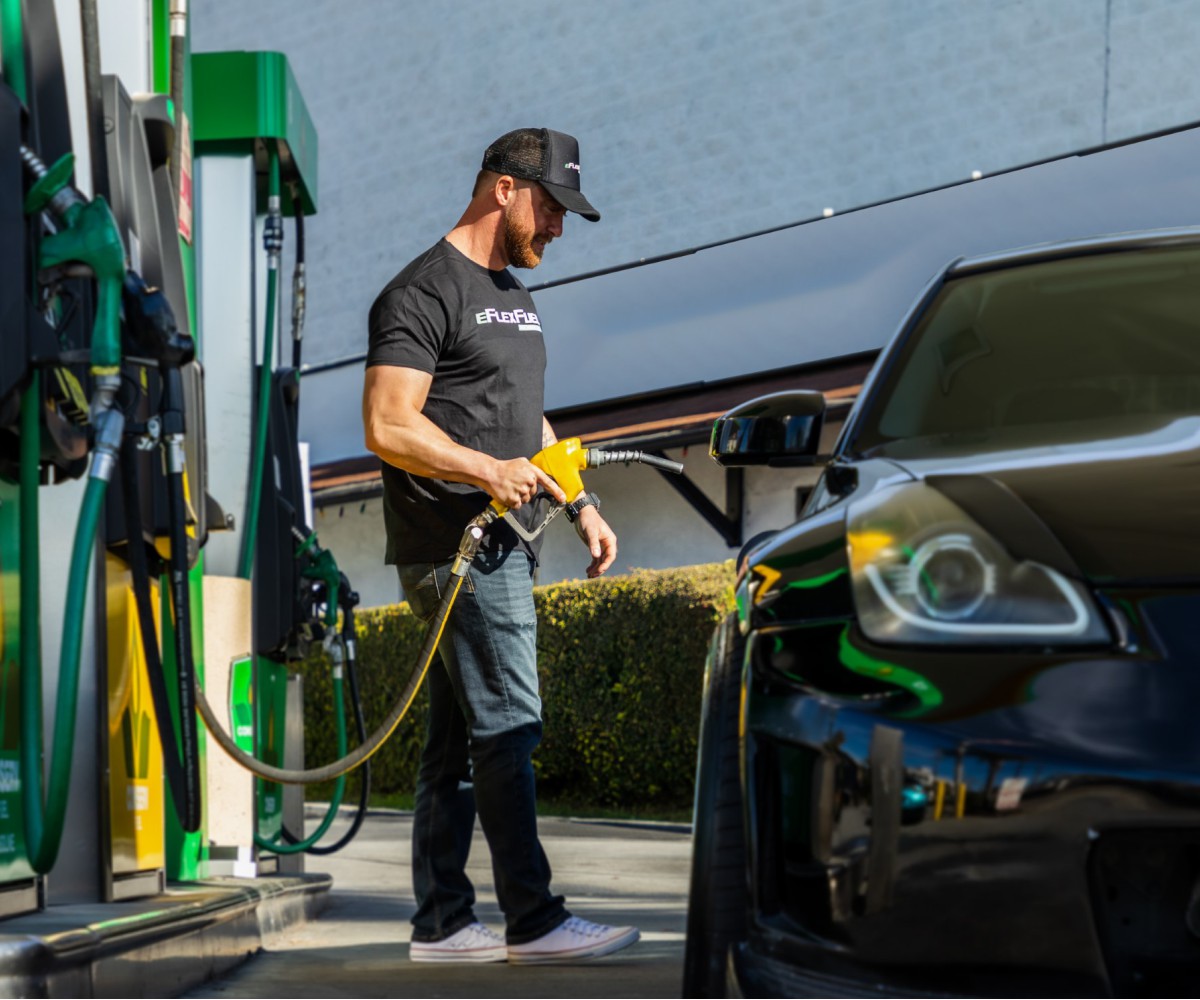
Unlock Performance With Every E85 Fill Up
Install an eFlexFuel kit and you’ll instantly improve performance every time you fill up with E85. Because E85 has a ridiculously high octane and knock resistance with quicker flame propagation than gasoline, running E85 yields greater engine horsepower, torque, and responsiveness. Furthermore, the high ethanol content dramatically increases charge cooling, promoting consistent performance gains regardless of operating conditions. You know that cold feeling you feel when using alcohol hand sanitizer? The same thing is happening in your cylinder immediately prior to combustion as ethanol atomizes and vaporizes.
Still doubtful about the performance gains of eFlexFuel + E85 without tuning? Check out these dynos from eFlexFuel equipped vehicles. Only difference between the runs are fuel type: E85 Vs Gas!
eFlexFuel + E85 Vs. Gas Dyno Results
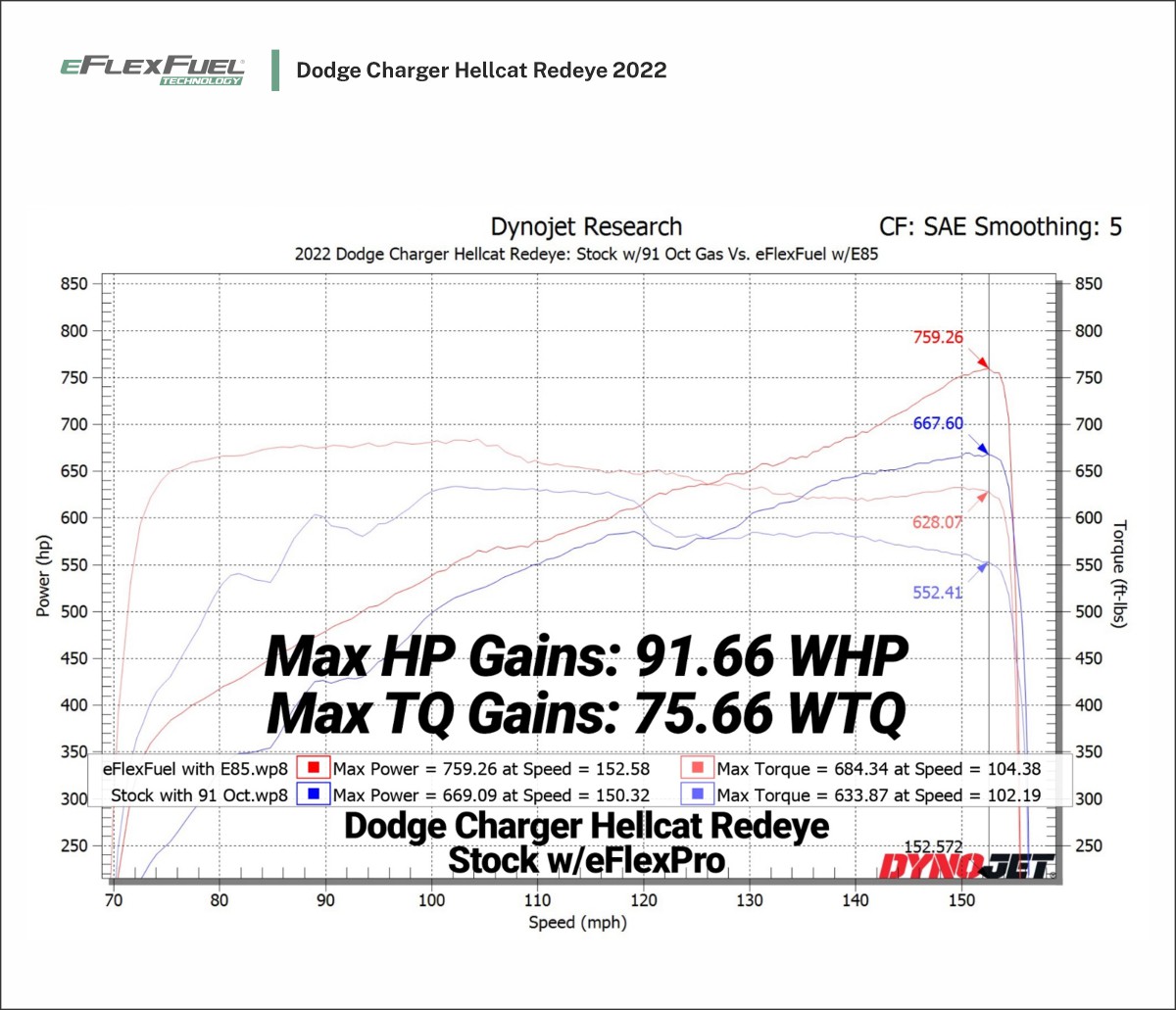

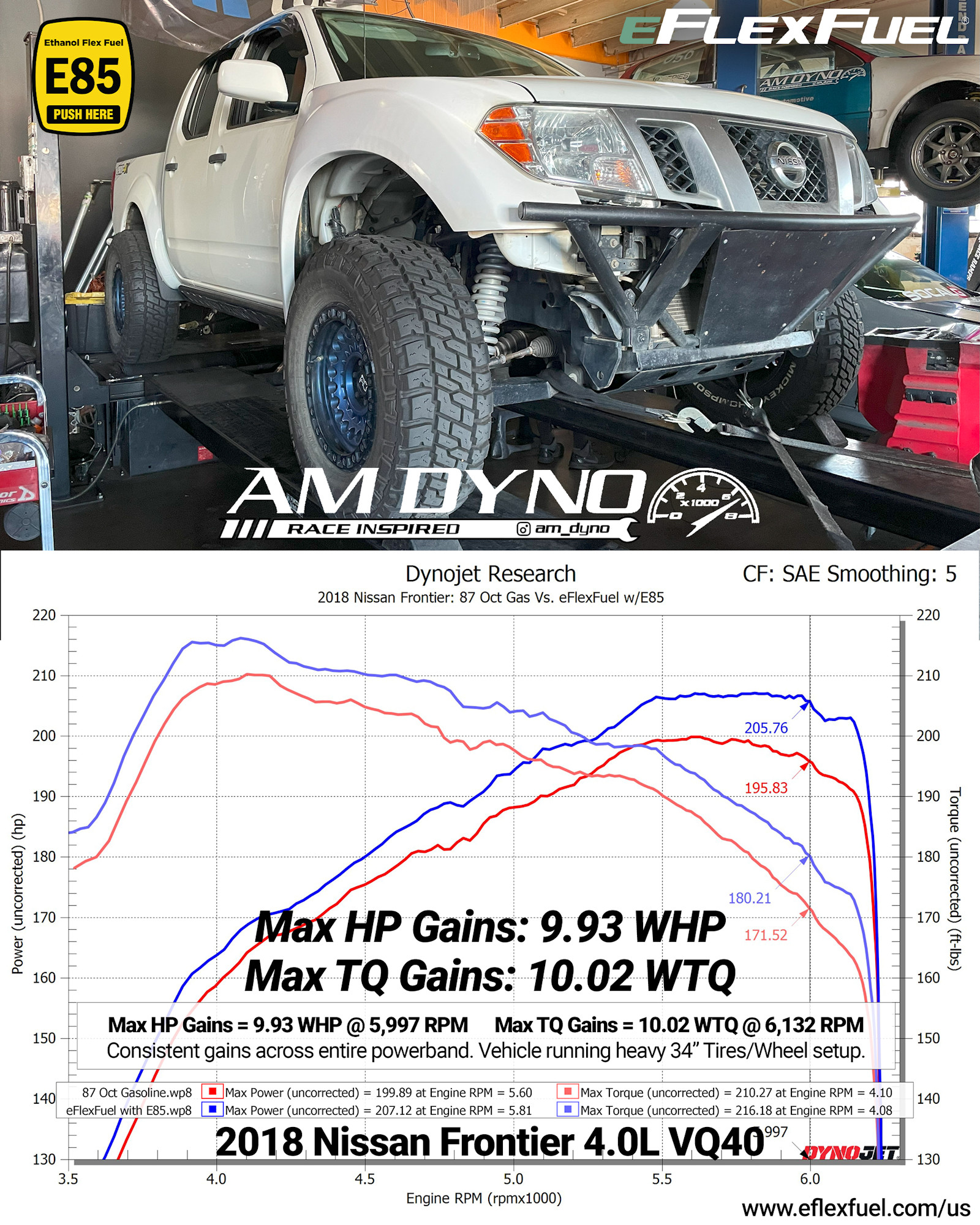
Peak power gains do not always tell the whole story! It's important to look at power gains across the entire RPM range / dyno curve, A.K.A. power "under the curve." Power gains under the curve will have a greater impact on driving experience. This is because gains under the curve impact the broader usable powerband, whereas peak power is momentary - only at one point in the RPM range.
If peak gains are 5% while max gains under the curve show 20%, this +20% increase is a better reflection of how your driving experience will change (you'll certainly feel that increase!). You want to feel the difference in the seat of your pants, and this is where power under the curve plays usually the biggest role.
“IT DOESN’T WORK LIKE THAT” -Internet Keyboard Warrior
Spoiler alert, Mr. Internet Know-It-All is wrong. For whatever reason, E85 content attracts comments from keyboard warriors and “internet experts” who think they know better (but actually don’t). We’ve been told it’s “impossible” and that our kits can’t do what we claim from people who have never touched our products or taken the time to learn about them.
We stand behind our products and guarantee they operate as advertised. If you install an eFlexFuel kit and have issues or get a check engine light running E85, we’ll troubleshoot the situation with you and help you fix the error (99.9% of the time we find an issue with the installation). If we can’t get to the bottom of the issue after exploring installation and warranty replacement parts, we’ll take the kit back and issue you a full refund, though it never gets that far. Bottom line, our kits work and do what we say they’ll do.
The point is, we’ve sold over 65,000 kits that have over 2,500,000,000 miles driven on eFlexFuel kits. It’s definitely safe to say, “It does work like that.”
+No Check Engine Lights
eFlexFuel kits were engineered to work with your vehicle’s ECM and fuel system, not against them! As a result, the vehicle’s ECM retains ideal operating parameters when an eFlexFuel kit is installed whether you’re running E85, gasoline, or any mixture of the two. Because the ECM’s target parameters are met, emissions performance remains optimal, and your Check Engine Light has no reason to illuminate.
+Cleaner Fuel System And Cleaner Combustion
E85 burns cleaner than gasoline—its high oxygen content helps engines produce fewer harmful emissions and prevents carbon deposits from forming. Over time, E85’s natural solvent properties will even clean existing buildup in your fuel system and engine, keeping internals running smoothly. E85’s cleaner combustion also significantly reduces your Carbon Footprint.
Save Money By Running E85 Via eFlexFuel
It’s been drilled into our heads to think of MPG when we think of fueling costs. To really get the whole picture, we need to think of MPG and fuel cost together, rather than just one or the other.
On E85 your fuel consumption will go up but your fuel cost will go down. Science says that as ethanol percentage increases, so does fuel volume. Running E85 usually means up to a 10-20% decrease in Miles Per Gallon but the amount depends on the type of vehicle, how it’s being driven, and the exact E% in your tank. Because E85 is usually much cheaper than gas, the final cost per mile is typically far lower on E85 making it the clear winner to save money, but let’s do the math to prove it:
How far will $30 get you on Gas Vs E85?
Here’s a simple example with math to determine the winner. Let’s set the stage with these assumptions:
Your vehicle averages 25MPG on gas:
- Gas Price is $5.00 per gallon
- E85 Price is $3.25 per gallon
In some cases the price gap between E85 and gas is even bigger, making savings even greater!
Analyzing gasoline fueling costs:
- If gas is $5.00 per gallon and you are spending $30, you’ll get 6 gallons of gas. ($30/$5 per gallon = 6 gallons)
- If your vehicle gets 25MPG on gas, you’ll have a total range of 150 miles. (25MPG x 6 gallons = 150 miles)
- That means $30 of gas got you 150 miles, which is the same as paying 20 cents per mile in fuel costs. ($30 / 150 miles = $0.20 per mile)
Analyzing E85 fueling costs:
- If E85 is $3.25 per gallon and you are spending $30, you’ll get 9.2 gallons of E85. ($30/$3.25 per gallon = 9.2 gallons)
- If your vehicle gets 25MPG on gas, we can estimate you will get around 20-22.5MPG on E85. (10-20% decrease of MPG)
- If you get 20-22.5MPG on E85, you’ll have a total range of 172-193.5 miles. (20MPG x 9.2 gallons = 184 miles & 22.5MPG x 9.2 gallons = 207 miles).
- That means $30 of E85 got you 184-207, miles which is the same as paying 14-16 cents per mile in fuel costs. ($30 / 184 = $0.16 & $30 / 207 = $0.14)
Key Takeaways:
- Spending $30 on gas gave a range of 150mi while spending $30 on E85 gave a range of 184-207 miles.
- That’s a 23-38% increase in range by filling up E85 with eFlexFuel!
- It cost 20 cents per mile to drive on gasoline but only 14-16 cents per mile to drive on E85.
- That’s a 20-30% decrease in actual fueling costs with eFlexFuel & E85!
- It would cost $4,000 to drive 20,000 miles on gasoline. It would only cost $2,800-3,200 to drive the same distance on E85.
- That’s a savings of $800-1,200 by driving with eFlexFuel & E85!
Use the calculator below to calculate your savings running E85 via eFlexFuel
Average annual mileage is around 15,000 miles.
Most cars average 30mpg, most SUVs average 25mpg, and most trucks average 18mpg.
Running E85 requires more fuel. Smaller vehicles (e.g. Toyota Prius) may see a decrease around 10-15% while larger vehicles typically see a decrease of 15-20% MPG.
If you don't know how much E85 costs in your area, visit E85Prices.com
Consider whether your vehicle requires Standard or Premium gasoline.
If you don't know how much gas costs in your area, visit AAA's gas price map.
About Fuel Consumption help
Consumption on E85 varies depending on what kind vehicle you drive. Usually smaller and newer cars have lower consumption increase compared to gasoline than bigger and older cars. Hybrids also tend to have smaller consumption increase. This is due to the fact that newer vehicles tend to be more able to benefit from E85's better knock resistance than older vehicles. In emission lab conditions, by measuring fuel weights, we have generated as low as 12% difference between regular gasoline and E85 on a hybrid vehicle.
Driving style/environment also affects how much E85 mileage turns out to be compared to gasoline. Fast driving with varying speeds and a lot of accelerations tends to lower E85 mileage (20 to 30% lower than of gasoline) while easy driving with steady speeds for long sequences tends to generate significantly higher mileage (10 to 20% lower than gasoline). With E85, this phenomenon is amplified compared to gasoline. More performance oriented engines typically run with slightly rich AFR for safety reasons and this increases the consumption in demanding driving conditions and in high output engines.
saved
in 3 years
metric tons CO2 saved in 3 years
Equally to plant and grow trees annually
Flights from L.A. to San Francisco
+E85 Sounds Too Good To Be True – What Are The Cons?
We’re firm believers that the benefits of E85 via eFlexFuel outweigh the downsides, but it’s important to understand the entire picture and come to your own conclusion:
MPG Changes: As mentioned above, MPG will decrease when running higher ethanol blends. While this is typically offset by lower costs of E85, If the cost of E85 is the same as the cost of gasoline, then it will be more expensive to run E85 than gas. Check out the Cost Savings section above for more info, a real world example, and a cost savings calculator.
Preventative Maintenance for High Mileage Vehicles: If your vehicle has over 125,000 miles, you should consider replacing your fuel pump as a preventative maintenance item. E85 requires a higher volume of fuel, and the reality is, your fuel pump will be flowing more. Old and high mileage wear-parts like fuel pumps, spark plugs, and coil packs have their limits so it’s important to be realistic about the age and mileage of your vehicle. That said, we have customers with 200,000+ miles on their original fuel pump running strictly E85 without issue.
+Won’t Ethanol Destroy My Engine, Fuel System, Or Oil? I Saw That Online Somewhere.
Remember the show “Mythbusters”? We wish it was still around so they could just do an episode on E85 and save us the hassle of setting the record straight. The common myths around E85 originate in truth but no longer apply in 2025. Let’s review these claims one by one:
- Ethanol and Engine Safety: Without proper fuel management, high ethanol blends can wreak havoc on an engine’s components! However, proper fuel management is exactly what eFlexFuel kits do, ensuring proper AFRs are delivered so the vehicle achieves its stoichiometric combustion targets. With an eFlexFuel kit installed, rest assured your engine is perfectly safe running high ethanol blends like E85.
- Ethanol and Fuel System Compatibility: This misconception originates from the days of natural rubber fuel lines and cork gaskets, components that existed in fuel systems 35-45+ years ago. Modern fuel systems, especially those produced after 2000 and intended for the US market, were designed to tolerate ethanol since ethanol was being introduced into fuel in the early-mid 1990’s. This myth about ethanol “melting fuel lines” has been busted time and time again, which is why E85 conversions are rapidly growing in popularity around the world.
- Ethanol and Oil Compatibility: There’s a common myth that engine oil is incompatible with E85 and will break down in lubricity and detergency prematurely. This was true decades ago but was directly corrected by the oil industry when E85 was first gaining popularity in the US. In 2010, the American Petroleum Institute (API) released updated oil standards that directly addressed this concern. Starting in 2010, updated oil standards required passing the American Society for Testing and Materials (ASTM) D7563 test for E85 compatibility, verifying that no water separation or additive dropout could occur.
The common theme with myths around E85 – they’re based in truth but are outdated and no longer relevant in 2025.
+Fact Or Fiction: Running E85 Is Good For The Planet
- Substantial Greenhouse Gas Reductions Rivaling EVs: E85 significantly lowers greenhouse gas (GHG) emissions compared to gasoline. Recent studies from Argonne National Laboratory, Harvard, MIT, and the USDA confirm that corn ethanol’s carbon intensity is 44–52% lower than gasoline, with some production methods achieving up to a 61% reduction 9 11. Research from IFP Energies nouvelles (IFPEN) in 2022 and 2024 further shows that 100% renewable Superethanol-E85 can match or even outperform all-electric vehicles in life cycle GHG emissions, especially in plug-in hybrid applications 1 4.
- Cleaner Air and Fewer Harmful Emissions: E85 reduces tailpipe emissions of particulate matter (soot), carbon monoxide (CO), and toxic compounds such as benzene and 1,3-butadiene, compared to gasoline. The U.S. Environmental Protection Agency (EPA) and studies by the Swiss Federal Laboratory have found that E85 can cut particulate emissions by more than 95% and lower emissions of several air toxics, contributing to improved air quality and public health 5 7 9.
- Ongoing Progress Toward Net-Zero Carbon: Advances in ethanol production, including the use of renewable energy and improved agricultural practices, are steadily reducing the carbon footprint of E85. The Renewable Fuels Association and recent peer-reviewed research indicate that next-generation ethanol technologies could push GHG reductions to 70% or more, with some cellulosic ethanol processes already achieving reductions of 80% or higher 9 1. IFPEN’s research also highlights that renewable E85 is on a clear path to meeting future Euro 7 emissions standards and achieving net-zero carbon goals 1 4.
- Lifecycle Environmental Benefits: The environmental advantages of E85 are most pronounced when considering the full lifecycle—from crop growth (which absorbs CO₂) to fuel production and use. Argonne National Laboratory’s long-term analysis shows that as ethanol production has become more efficient, its overall carbon footprint continues to shrink, making E85 a sustainable alternative to fossil fuels 11 9.
These findings, supported by leading laboratories, universities, and government agencies, demonstrate that E85 is a proven, environmentally responsible fuel that can play a key role in reducing transportation emissions and supporting climate goals.
The fact of the matter is, running E85 responsibly IS good for the planet!
+Doesn’t E85 Require A Lot Of Farming? I’ve Heard That’s The Real Issue With E85 And The Environment.
This is another one of those ideas that used to be true but isn’t really the case in 2025 anymore. Concerns about the environmental effects of ethanol production—especially regarding land use and fertilizer application—are often based on outdated information or misconceptions. Recent data and scientific reviews from leading institutions and government agencies provide a much clearer, more positive picture:
- Fertilizer Use Has Declined: Contrary to the belief that ethanol demand drives up fertilizer use, USDA data show that U.S. corn farmers have actually reduced fertilizer application rates per bushel by more than 50% for nitrogen and nearly 70% for phosphate and potash since 1970. Modern farming techniques and precision agriculture have enabled growers to produce more corn with fewer inputs, resulting in less environmental impact from fertilizer runoff 5.
- No Significant Expansion of Cropland: Claims that ethanol production requires more farmland are not supported by recent evidence. According to the EPA and USDA, total U.S. cropland has declined in recent years, and corn acreage has remained stable or even decreased compared to the early 20th century. Increases in corn yields—now averaging nearly 180 bushels per acre, up from 150 in the early 2000s—are due to improved seed genetics, better management, and technology, not land expansion 5 3.
- Land Use Change Concerns Overstated: Comprehensive studies, including recent reports submitted to the EPA and research from Ramboll and Environmental, Health and Engineering, Inc., find no credible evidence that the Renewable Fuel Standard (RFS) has caused significant land conversion or harmed wetlands, wildlife habitats, or water quality. The best available science and improved modeling techniques show that the carbon intensity of corn ethanol related to indirect land use change is much lower than previously estimated 3.
- Energy Efficiency and Environmental Gains: Today’s corn ethanol provides nearly three times the energy used to produce it, thanks to advances in both farming and biorefinery technology. Analyses by the USDA, Argonne National Laboratory, and the University of Nebraska show that modern ethanol production is far more energy-efficient and results in 40–50% lower greenhouse gas emissions compared to gasoline 5 6 8.
- Addressing Critical Studies: Some recent studies, such as the 2022 “Lark Study,” have been criticized by experts from Argonne National Laboratory, Harvard, MIT, Tufts, USDA, Purdue, and others for methodological flaws and inaccurate conclusions. The scientific consensus, based on robust, peer-reviewed research, is that ethanol delivers substantial climate and air quality benefits, with a ~45% reduction in CO₂ emissions compared to gasoline 3 5.
The latest research from universities, national laboratories, and federal agencies demonstrates that ethanol farming is becoming more sustainable, with reduced fertilizer use, stable land requirements, and significant environmental benefits. These improvements are the result of ongoing innovation and a commitment to responsible agricultural practices.



